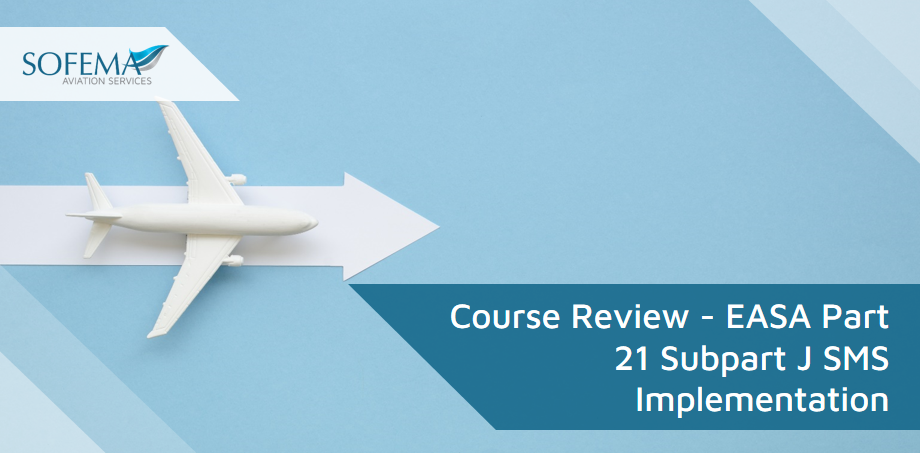Sofema Aviation Services (SAS) www.sassofia.com considers EASA Part 21 Subpart J Safety Management System training course provided by SAS and it’s key features
The training material demonstrates a robust and comprehensive approach to supporting participants in understanding and implementing Safety Risk Management (SRM) within EASA Part 21J and Part 21G organizations. Below are the key positive attributes identified in the training content:
Comprehensive Coverage of Part 21 Subpart J Safety Management System (SMS)
- SMS Framework Integration:
- The material effectively integrates the four components and twelve elements of the ICAO SMS framework, ensuring alignment with regulatory requirements.
- Clear emphasis on SMS principles as outlined in ICAO Annex 19 and EASA regulations.
- Emphasis on Safety Culture:
- Strong focus on fostering a positive safety culture within the organization.
- Highlights the importance of leadership commitment, proactive safety reporting, and cross-functional collaboration.
- Connection Between Safety Assurance and Risk Management:
- Detailed exploration of the relationship between SRM and Safety Assurance, emphasizing their complementary roles in achieving safety objectives.
Well-Structured Risk Management Processes
- Proactive and Predictive Approaches:
- Incorporates proactive and predictive methods for hazard identification and risk management.
- Includes detailed steps for analysis, assessment, and mitigation of risks.
- Application of Analytical Tools:
- Introduces tools such as bow-tie analysis and fishbone analogy to facilitate effective risk management.
- Safety Performance Monitoring:
- Discusses the importance of leading and lagging indicators with practical examples to support continuous improvement.
Practical Implementation of Safety Management Principles
- Workshops and Case Studies:
- Incorporates practical workshops, such as the Boeing 737 MAX grounding, to enhance participant understanding.
- Provides actionable insights through real-world examples.
- Integration of SMS into Organizational Processes:
- Highlights the integration of SMS into Design Management Systems (DMS) to ensure safety throughout the design lifecycle.
- Focus on Continuous Improvement:
- Emphasizes ongoing evaluation and refinement of safety processes, aligning with Annex 19 principles.
Emphasis on Key Competencies
- Training and Competency Development:
- Provides a comprehensive overview of the training requirements for safety personnel, ensuring alignment with SMS principles.
- Focuses on building competence through instructional design, continuous professional development (CPD), and scenario-based training.
- Human Factors Consideration:
- Addresses the role of human factors in SRM, emphasizing error management and organizational culture.
Clear Communication and Reporting Frameworks
- Safety Reporting Systems:
- Provides clear guidelines for internal and external reporting, aligning with ICAO and EASA standards.
- Highlights the value of non-punitive reporting mechanisms in fostering a culture of openness.
- Stakeholder Engagement:
- Encourages collaboration and communication across departments, reinforcing the importance of shared safety responsibilities.
Alignment with Regulatory Standards
- Conformance with EASA and ICAO Requirements:
- Thoroughly aligns training content with EASA Part 21 Subpart J and Subpart G regulations.
- Ensures integration of ICAO Annex 19 safety principles within organizational practices.
- Focus on Compliance and Oversight:
- Detailed coverage of compliance requirements, occurrence reporting, and internal auditing processes.
Balanced Approach to Safety and Operational Goals
- Safety vs. Cost, Performance, and Innovation:
- Highlights the need to balance safety with other organizational goals, such as cost-effectiveness and innovation.
- Promotes a nuanced understanding of trade-offs in design and production processes.
- Tailored Guidance for Implementation:
- Offers practical strategies for achieving SMS compliance, leveraging existing organizational practices to minimize disruption.
Well-Defined Organizational Roles and Responsibilities
- Role Clarity:
- Clearly outlines the roles and responsibilities of key stakeholders, including Safety Managers, Heads of Design Organizations, and Safety Review Boards.
- Ensures accountability at all levels of the organization.
- Support for Leadership and Governance:
- Highlights the importance of senior leadership in championing SMS initiatives and promoting safety culture.
Innovative and Participant-Centered Design
- Interactive Learning:
- Encourages active participation through workshops, discussions, and exercises.
- Promotes collaboration and knowledge sharing among participants.
- Practical Focus:
- Aligns training content with real-world applications, ensuring participants can directly apply learning to their organizational context
Next Steps
Follow this link to our Library to find & download related documents for Free.
For additional SMS and Part 21 Regulatory courses, please see Sofema Aviation Services and Sofema Online or email team@sassofia.com.
Tags:
EASA, ICAO, Risk Management, Safety Management System, Safety Management System SMS, easa part 21, EASA Part 21 Subpart J, SAS blogs, continuous improvement, Competency Development, Safety Reporting Systems, Tailored Guidance, Role Clarity





